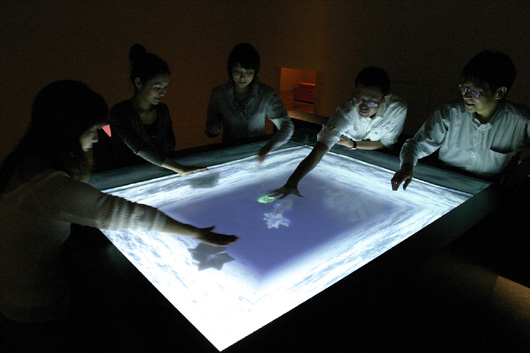"A-Volve"
1994
1994
Christa SOMMERER & Laurent MIGNONNEAU

This work features a tank to keep virtual life forms that are transformed from the drawing made on a computer touch screen. The artificial organisms adapt to both the real and virtual environments, and influence each other. These creatures can live long if their shape fits with the environment, or may produce offspring of other organisms, while the strong may eat the weak. You can put your hand into the tank to protect a creature from attack, or guide it to move in a different direction.
Not only can the natural environment be observed but also changed under the influence of the viewer. This work simulates such interaction in a virtual environment. An organism will have agility and strong muscles if they are designed with a good shape. Further, its adaptability is tested by the water pressure and its relationship with the movement of other organisms. Genetic algorithm that decides the unique shape is exchanged between two or more organisms and inherited by their offspring. The artists position their approach to visual expression using artificial life in the extension of the "process-oriented" art trend from the 20th century, which is represented by Kurt Schwitters, Robert Rauschenberg, and Fluxus, and so on.
A-Volve was produced in 1994 with collaboration of Thomas Ray, an invited researcher at ATR Human Information Processing Research Laboratories, and in cooperation with the ICC. Christa SOMMERER, who studied plant biology and art, and Laurent MIGNONNEAU, who studied media and video, have been collaborating since 1992 based on the concept of "Art as a Living System" and are renowned as the leading creators of interactive art. From 1994 through 2004, they worked in Japan as artists/scholars-in-residence at the Advanced Telecommunications Research Institute International (ATR) in Kyoto and were associate professors at IAMAS (Institute of Advanced Media Arts and Sciences+International Academy of Media Arts and Sciences) in Gifu. Currently they are teaching at the Institute of Media Design in the University of Art and Industrial Design, Linz (Austria).
Christa SOMMERER, who studied plant biology and art, and Laurent MIGNONNEAU, who studied media and video, have been collaborating since 1992 based on the concept of "Art as a Living System" and are renowned as the leading creators of interactive art. From 1994 through 2004, they worked in Japan as artists/scholars-in-residence at the Advanced Telecommunications Research Institute International (ATR) in Kyoto and were associate professors at IAMAS (Institute of Advanced Media Arts and Sciences+International Academy of Media Arts and Sciences) in Gifu. Currently they are teaching at the Institute of Media Design in the University of Art and Industrial Design, Linz (Austria).
Not only can the natural environment be observed but also changed under the influence of the viewer. This work simulates such interaction in a virtual environment. An organism will have agility and strong muscles if they are designed with a good shape. Further, its adaptability is tested by the water pressure and its relationship with the movement of other organisms. Genetic algorithm that decides the unique shape is exchanged between two or more organisms and inherited by their offspring. The artists position their approach to visual expression using artificial life in the extension of the "process-oriented" art trend from the 20th century, which is represented by Kurt Schwitters, Robert Rauschenberg, and Fluxus, and so on.
A-Volve was produced in 1994 with collaboration of Thomas Ray, an invited researcher at ATR Human Information Processing Research Laboratories, and in cooperation with the ICC.


 | Artificial Life |
"Artificial Life" refers to non-biological life-like systems that can learn by themselves through inter-dependency and repeat self-replication by using machines or computers. Recent years have seen advances in research into the essence of life through simulation. Contemporary art expressions also focus on the "process" to turn the spotlight onto the uncertainty that has the same infinite possibilities as life itself.

